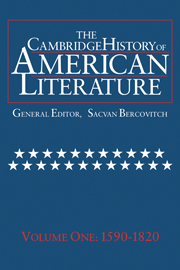Book contents
- Frontmatter
- Introduction
- THE LITERATURE OF COLONIZATION
- 1 The Papers of Empire
- 2 The Natural Inhabitants
- 3 Three Writers of Early America
- 4 Settlements
- 5 The Dispute of the New World
- 6 Traveling in America
- 7 The Final Voyage
- NEW ENGLAND PURITAN LITERATURE
- BRITISH-AMERICAN BELLES LETTRES
- THE AMERICAN ENLIGHTENMENT, 1750–1820
- THE LITERATURE OF THE REVOLUTIONARY AND EARLY NATIONAL PERIODS
- Chronology
- Bibliography
- Index
3 - Three Writers of Early America
from THE LITERATURE OF COLONIZATION
Published online by Cambridge University Press: 28 March 2008
- Frontmatter
- Introduction
- THE LITERATURE OF COLONIZATION
- 1 The Papers of Empire
- 2 The Natural Inhabitants
- 3 Three Writers of Early America
- 4 Settlements
- 5 The Dispute of the New World
- 6 Traveling in America
- 7 The Final Voyage
- NEW ENGLAND PURITAN LITERATURE
- BRITISH-AMERICAN BELLES LETTRES
- THE AMERICAN ENLIGHTENMENT, 1750–1820
- THE LITERATURE OF THE REVOLUTIONARY AND EARLY NATIONAL PERIODS
- Chronology
- Bibliography
- Index
Summary
In certain passages of the story of America's exploration and colonization, literature has history coming and going. If, as we suggested earlier, literature in the sixteenth century often instigated history, sometimes the major legacy of the history was the literature it produced. The unsuccessful attempt to establish an English post on Roanoke Island left not even a significant ruin, but it did give rise to the first book about the New World written in English: Thomas Harriot's A Brief and True Report of the New Found Land of Virginia (1588, 1590). Harriot's book is an objective account of conditions in the New World; rather, it means to be objective. John Smith produced the first writings in a more subjective mode, which would become equally important in the literature. For Smith the New World was not only a site for imperial development but a theater of self-development as well. His major work, The General History of Virginia, New England, and the Summer Isles (1624), also claims to be a “true report,” but along with accounts of natural resources and local hazards, it interweaves a narrative of Smith's career, often told in the third person. Finally, the most likely candidate for first American book written in English (Smith was not an American) is Roger Williams's 1643 A Key into the Language of America. These three works are the focus of this chapter.
Thomas Harriot's A Brief and True Report of the New Found Land of Virginia was published in haste to support Walter Raleigh's petition to the queen not to abandon the Virginia colony, whose first settlement had just failed. A second edition was brought out by the Flemish engraver and publisher Theodor de Bry two years later as part of a projected series entitled America, and it was multilingual (Latin, German, French, and English). Harriot had collected notes for a much more extensive chronicle, but most of his papers were lost on the return voyage.
- Type
- Chapter
- Information
- The Cambridge History of American Literature , pp. 59 - 83Publisher: Cambridge University PressPrint publication year: 1994

